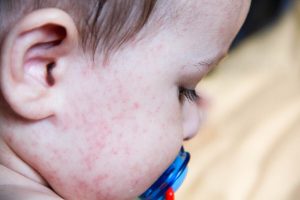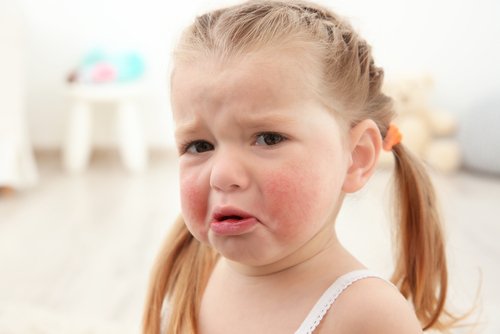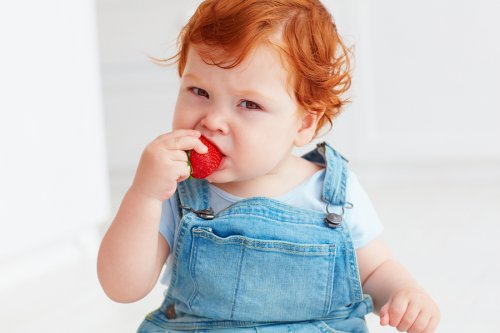The Most Common Food Allergies in Children


Reviewed and approved by the doctor Nelton Ramos
It’s very important that parents know what types of foods can cause allergies in children. Furthermore, they need to know how to recognize the symptoms that their child’s body may produce.
Finally, parents must also be aware of the differences between food allergies and food intolerances, and how to introduce possible allergens into a child’s diet.
Unfortunately, if a person is allergic to certain foods, this is a permanent condition. Therefore, it’s imperative to know the types of reactions they can produce. At the same time, prevention is your best defense.
Common food allergies in children
Food allergies that are common in children can arise from the ingestion of any food. However, without a doubt, certain foods tend to cause a flare-up.
Therefore, it’s very important that parents know how to identify the symptoms of food allergies. At the same time, they need to understand the clear distinction between food allergies and food intolerances.
Symptoms of food allergies
Food allergies can show up in the form of skin problems, breathing difficulties and digestive issues, such as the following:
- Local or generalized rash.
- Inflamatory illnesses of the skin.
- Bronchospasm.
- Bronchuial Asthma.
- Rhinitis.
- Hives.
- Swelling of the tongue.
- Swelling of the mouth.
- Bulging of the eyelids.
- Anaphylaxis.

These common food allergy symptoms can appear 30 minutes after your child has consumed an allergen.
In most cases, they can take 2 to 3 hours to show up. In fact, symptoms can take up to 5 days to appear, such as the case with inflammatory skin illnesses.
Contrast between allergy symptoms and symptoms of food intolerance
The signs of food intolerance have to do with the metabolic system. Basically, they show up as digestive problems due to difficulties in processing certain foods.
The three main symptoms of food intolerances are gas, stomach swelling and diarrhea or loose stool.
Foods that frequently cause allergic reactions in children
The list of foods is varied and includes the following items:
- Peanuts or peanut butter.
- Fish and seafood.
- The proteins found in cow’s milk.
- Wheat.
- Soy.
- Nuts.
- Eggs.
- Strawberries.
- Peaches.
- Kiwi.
- Gluten.
“It’s very important that parents know how to identify the symptoms of food allergies. At the same time, they need to understand the clear distinction between food allergies and food intolerances.”
How to prevent food allergies in children
Specialists claim there is no real method for preventing food allergies in children.
Most pediatricians recommend holding off before introducing possible allergens into your little one’s diet until they are a bit older. This is because allergic reactions are more dangerous in small babies.
Other options include introducing the foods one at a time and keeping a written diary of how your child processes each one.
Observe your child for the next few days and watch for any unfavorable reactions. If everything is okay, then you can introduce another item and repeat the same process.
It’s important not to introduce more than one or two items on the list at a time. This is because you’ll be unable to determine which of the foods your child is allergic to in case of a reaction.
Unfortunately, there is no way to get rid of food allergies. Experts believe that allergies have to do with hereditary factors.
Therefore, if there is a history of food allergies in the family, then it’s best to be very careful when introducing these foods into your little one’s diet. There are higher chances of them provoking an allergic reaction.

At the same time, you need to be extremely detailed in reading labels on the packages of the foods you give your child.
Many products can contain traces of peanuts or small amounts of other substances that can produce an allergic reaction. Without a doubt, prevention is the only solution.
Final considerations
If you’ve identified foods that cause an allergic reaction in your child, then you should see a pediatrician. Your child’s doctor will indicate that you should eliminate the item completely from your child’s diet.
Furthermore, he or she will provide you with a nutritional guide to help you find new alternatives. That way, you can be sure your child is still getting all the nutrients he or she needs.
Lastly, if your child presents a severe allergic reaction including swelling, difficulty breathing or anaphylactic shock, then you should seek emergency medical treatment immediately.
It’s very important that parents know what types of foods can cause allergies in children. Furthermore, they need to know how to recognize the symptoms that their child’s body may produce.
Finally, parents must also be aware of the differences between food allergies and food intolerances, and how to introduce possible allergens into a child’s diet.
Unfortunately, if a person is allergic to certain foods, this is a permanent condition. Therefore, it’s imperative to know the types of reactions they can produce. At the same time, prevention is your best defense.
Common food allergies in children
Food allergies that are common in children can arise from the ingestion of any food. However, without a doubt, certain foods tend to cause a flare-up.
Therefore, it’s very important that parents know how to identify the symptoms of food allergies. At the same time, they need to understand the clear distinction between food allergies and food intolerances.
Symptoms of food allergies
Food allergies can show up in the form of skin problems, breathing difficulties and digestive issues, such as the following:
- Local or generalized rash.
- Inflamatory illnesses of the skin.
- Bronchospasm.
- Bronchuial Asthma.
- Rhinitis.
- Hives.
- Swelling of the tongue.
- Swelling of the mouth.
- Bulging of the eyelids.
- Anaphylaxis.

These common food allergy symptoms can appear 30 minutes after your child has consumed an allergen.
In most cases, they can take 2 to 3 hours to show up. In fact, symptoms can take up to 5 days to appear, such as the case with inflammatory skin illnesses.
Contrast between allergy symptoms and symptoms of food intolerance
The signs of food intolerance have to do with the metabolic system. Basically, they show up as digestive problems due to difficulties in processing certain foods.
The three main symptoms of food intolerances are gas, stomach swelling and diarrhea or loose stool.
Foods that frequently cause allergic reactions in children
The list of foods is varied and includes the following items:
- Peanuts or peanut butter.
- Fish and seafood.
- The proteins found in cow’s milk.
- Wheat.
- Soy.
- Nuts.
- Eggs.
- Strawberries.
- Peaches.
- Kiwi.
- Gluten.
“It’s very important that parents know how to identify the symptoms of food allergies. At the same time, they need to understand the clear distinction between food allergies and food intolerances.”
How to prevent food allergies in children
Specialists claim there is no real method for preventing food allergies in children.
Most pediatricians recommend holding off before introducing possible allergens into your little one’s diet until they are a bit older. This is because allergic reactions are more dangerous in small babies.
Other options include introducing the foods one at a time and keeping a written diary of how your child processes each one.
Observe your child for the next few days and watch for any unfavorable reactions. If everything is okay, then you can introduce another item and repeat the same process.
It’s important not to introduce more than one or two items on the list at a time. This is because you’ll be unable to determine which of the foods your child is allergic to in case of a reaction.
Unfortunately, there is no way to get rid of food allergies. Experts believe that allergies have to do with hereditary factors.
Therefore, if there is a history of food allergies in the family, then it’s best to be very careful when introducing these foods into your little one’s diet. There are higher chances of them provoking an allergic reaction.

At the same time, you need to be extremely detailed in reading labels on the packages of the foods you give your child.
Many products can contain traces of peanuts or small amounts of other substances that can produce an allergic reaction. Without a doubt, prevention is the only solution.
Final considerations
If you’ve identified foods that cause an allergic reaction in your child, then you should see a pediatrician. Your child’s doctor will indicate that you should eliminate the item completely from your child’s diet.
Furthermore, he or she will provide you with a nutritional guide to help you find new alternatives. That way, you can be sure your child is still getting all the nutrients he or she needs.
Lastly, if your child presents a severe allergic reaction including swelling, difficulty breathing or anaphylactic shock, then you should seek emergency medical treatment immediately.
All cited sources were thoroughly reviewed by our team to ensure their quality, reliability, currency, and validity. The bibliography of this article was considered reliable and of academic or scientific accuracy.
- Barboza, F. (2009). Aspectos clínicos de la alergia alimentaria. Universidad del Valle.
- Rossel, G. M., & Araya, Q. M. (2011). Alergia alimentaria en la infancia. Revista Médica Clínica Las Condes, 22(2), 184-189.
- Toche, P. (2004). Alergia a alimentos y aditivos. Revista Médica Clínica las Condes, 15(3).
This text is provided for informational purposes only and does not replace consultation with a professional. If in doubt, consult your specialist.








